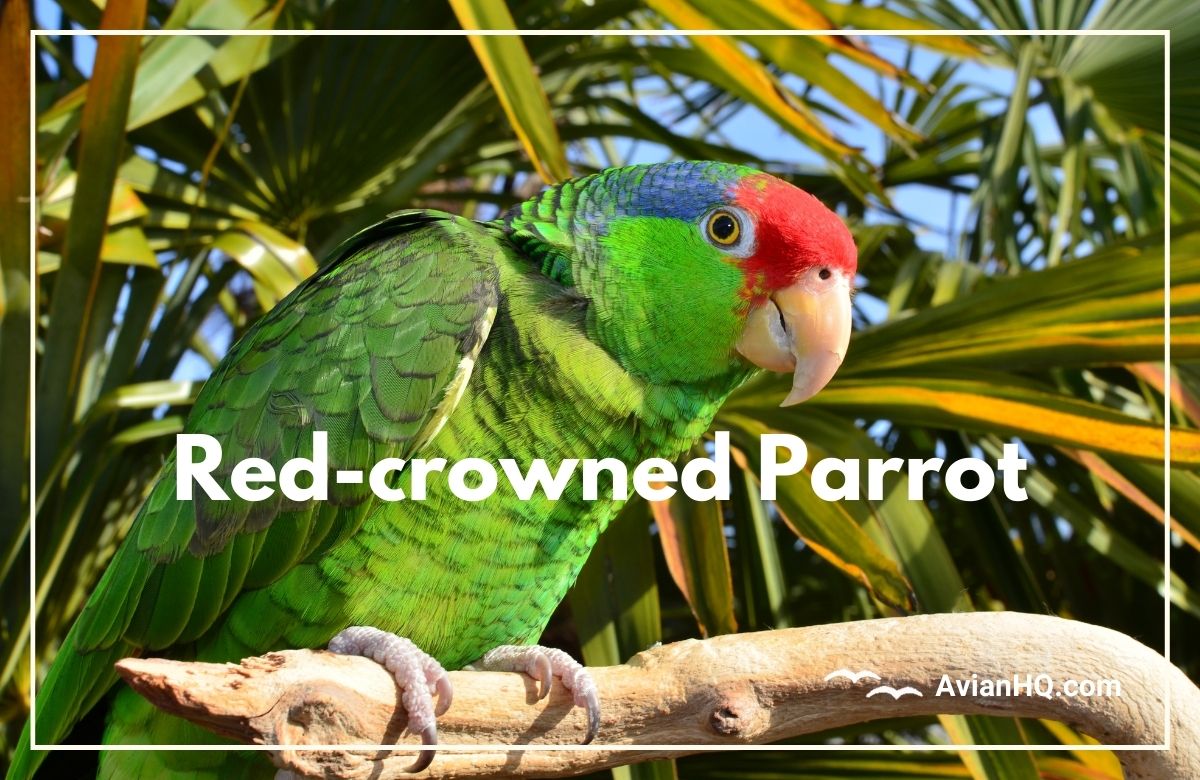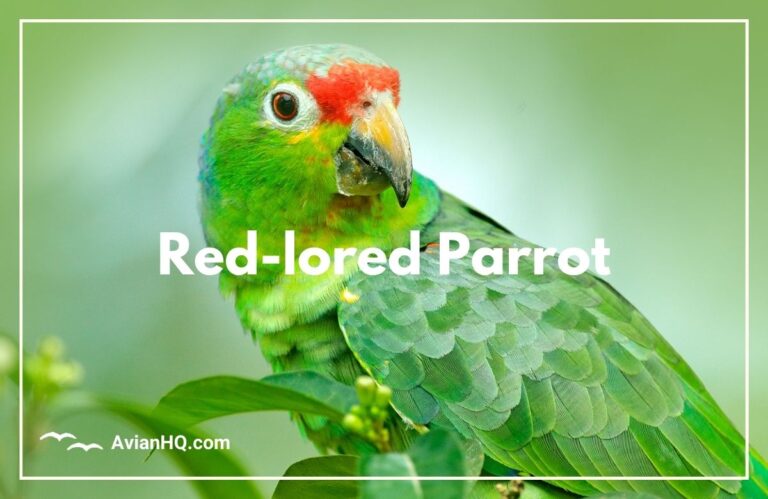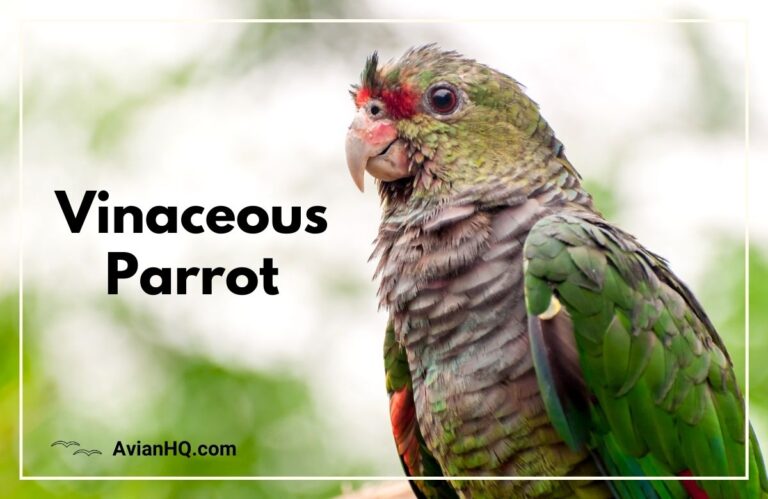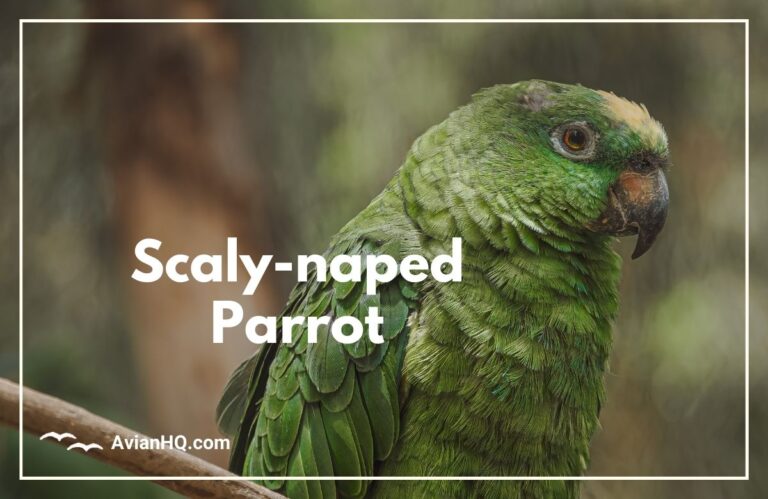Red-crowned Parrot (Amazona viridigenalis)
You catch a flash of red and green out of the corner of your eye. Glancing up, you spot a flock of parrots with bright red crowns perched in a palm tree. These colorful birds are Red-crowned Parrots, a species native to northeastern Mexico and possibly southernmost Texas.
“The Red-crowned Parrot is well established and its population is increasing in Los Angeles but in the wild is Endangered.”
Red-crowned Parrots stand out with their vivid green plumage accented by crimson feathers on the forehead and crown. When they take flight, you may glimpse bright red and blue patches under their wings. These parrots measure 11-13 inches (28-33 centimeters) long and can weigh up to 12 ounces (340 grams). Their wingspans reach up to 25 inches (64 centimeters).
While a welcome splash of color for city dwellers, wild populations of this Amazon parrot remain dangerously low. Loss of habitat and poaching for the pet trade have landed the Red-crowned Parrot a spot on the endangered species list. However, the adaptable bird has defied the odds by thriving in new urban environments in the United States. Feral flocks have taken up residence in cities like Los Angeles, San Diego, Miami, and beyond.
This article will delve into the natural history, physical description, habitat, behavior, conservation status, and cultural significance of the Red-crowned Parrot. Read on to learn more about this resourceful parrot’s fight for survival.
History and Taxonomy
The first written record of the Red-crowned Amazon Parrot dates back to 1885 in southern Texas. Ornithologists spotted these green parrots with crimson crowns flying on the Texas side of the Rio Grande River, likely wanderers from their native northeast Mexico.
Scientists first classified the species in 1871, giving it the scientific name Amazona viridigenalis. The genus name Amazona refers to these birds’ Amazonian origins. The species name viridigenalis combines the Latin words for “green” and “cheeks,” describing the parrots’ bright green plumage on the sides of the face. No distinct subspecies of the Red-crowned Parrot exist.
While some rumors floated that the parrots were escapees from the pet trade, proof of wild nesting pairs in Texas in the 1980s cemented their status as native inhabitants. Their numbers grew through the 1990s and 2000s. Today conservationists estimate roughly 700 Red-crowned Parrots dwell in the wild in South Texas.
Physical Appearance
The Red-crowned Parrot is a medium-sized parrot measuring 11-13 inches (28-33 cm) long. Their wingspans reach up to 25 inches (64 cm). Weights range from 9-12 ounces (255-340 grams).
As their name suggests, vibrant red feathers crown the foreheads of these parrots. The red patches extend partway down the nape. Blue feathers tinged with purple run in a band behind their eyes.
The majority of their plumage gleams in leafy hues of green. The greenest shades occur on the cheeks and throat. Their tails showcase yellowish-green bands along with blue flight feathers. Some individuals may display red and blue patches underneath their wings.
Males and females have similar coloration. Juveniles start out with less vibrant red crowns that intensify as they mature. Their eyes change too, from pale gray to brilliant yellow or reddish-orange irises by adulthood. All Red-crowned Parrots have horn-colored beaks and light beige legs.
No noticeable variations occur between different regional populations or subspecies, as the Red-crowned Parrot has only one recognized subspecies across its entire range.
Habitat and Distribution
The Red-crowned Parrot mainly occupies lowland forest and scrubland habitats in northeastern Mexico. Its native range stretches across the Mexican states of Tamaulipas, Nuevo Leon, and northern Veracruz.
Conservationists also now consider southernmost Texas part of the Red-crowned Parrot’s natural distribution. The parrot has inhabited the Rio Grande Valley of Texas for over a century after likely expanding its range north across the Rio Grande River.
Feral populations descended from escaped pets have also taken up residence in urban and suburban areas in California, Florida, Hawaii, and Puerto Rico. For example, Los Angeles County harbors an estimated population of over 3,000 Red-crowned Parrots.
In their native woodland habitat, Red-crowned Parrots stick to low elevations below 5,000 feet (1,500 m). They do not migrate and remain year-round residents across their range. The parrots appear well-adapted to manmade urban parks and gardens with ample roosting and nesting trees.
Diet and Feeding
Red-crowned Parrots enjoy a diverse herbivorous diet. They forage on seeds, fruits, flowers, buds, nuts, and sometimes nectar. Their menu varies depending on the regional vegetation.
Documented food items include figs, ebony, acorns, pine seeds, pecan nuts, avocados, corn, and leafy greens. The parrots have proven adaptable in sampling locally available foods in their introduced ranges. For example, scientists have identified at least 34 different urban food sources sustaining the Los Angeles population.
The parrots use their curved beaks adeptly to crack hard nuts and seeds. They employ their scaly tongues to draw nectar from flowers.
Red-crowned Parrots roam and feed in large, noisy flocks most of the year, especially outside breeding season. They wander over long distances of 15 miles (24 km) or more in search of ripening fruits and seed-laden trees. At night, the flocks congregate to roost communally in tall roosting trees.
Breeding and Reproduction
Red-crowned Parrots reach sexual maturity around 5 years of age. The breeding season lasts from April to June. Monogamous mating pairs break off to seek nesting sites.
The parrots nest in tree cavities, favoring tall palm trees. They exhibit high site fidelity, returning to the same nesting cavity year after year. The female lays a small clutch of 2-4 white eggs. She then incubates the eggs alone for about 28 days while the male brings food.
The altricial chicks hatch with closed eyes and little to no down. Both parents feed regurgitated seeds and fruits to the rapidly growing chicks. After around 9 weeks, the young fledge from the nest. However, the parents continue to care for them for some time as they learn to forage independently.
In captivity, Red-crowned Parrots have enjoyed lifespans over 50 years. However nest poaching and habitat loss in the wild likely results in shorter average longevities there.
Behavior and Ecology
Red-crowned Parrots exhibit very social behaviors. They spend most of the year roaming the countryside in large, noisy flocks of anywhere from 10 to over 100 birds. Peak activity occurs early morning and evenings when the flocks set out to forage.
Outside the breeding season, they congregate in traditional overnight roosting spots. These often consist of ridges with tall trees that give the flock members a nice vantage point. Estimated roost sizes range from less than 100 to over 300 birds.
While feeding, Red-crowned Parrots occasionally intermingle with other parrots like Yellow-headed and Red-lored Amazons. However they primarily associate with members of their own kind.
The adaptable birds also excel at exploiting manmade habitats. As mentioned, feral Red-crowned Parrot flocks continue to increase in urban areas within their introduced ranges. They nest in palms and garden trees and feed opportunistically on ornamental fruits, flowers, and seeds.
Conservation Status
The IUCN Red List categorizes the Red-crowned Parrot as Endangered. Its population shows a decreasing trajectory overall.
Survey data from the 1990s estimated the total global population at between 2,000-4,300 mature individuals. More recent research found 700 birds in Texas and over 3,000 in the Los Angeles area. However, the species likely remains in trouble in its native Mexico.
Major threats reducing wild Red-crowned Parrots include:
- Habitat loss as over 80% of the forest in northeastern Mexico has been cleared for agriculture
- Over-capture for the pet trade
- Persecution by farmers for crop damage
- Vulnerability of nests to poaching
On the positive side, the adaptable parrot has found refuge in some urban areas outside its native distribution. For example, the city of Brownsville, Texas named the Red-crowned Parrot its official city bird. If ample urban forests persist, these feral flocks may aid conservation of the species.
Cultural Significance
The Red-crowned Parrot’s adaptable, gregarious nature has enabled this endangered bird to find fans outside its native habitat.
In Texas, the parrot’s numbers continue to grow, especially in urban areas near the Mexico border like Brownsville and McAllen. The city of Brownsville adopted the Red-crowned Parrot as its official city bird in 2013. Townspeople seem to have enthusiastically embraced their flourishing neighbors.
On the opposite side of the country, escapees have created vibrant feral flocks in California. Los Angeles County now harbors over 3,000 Red-crowned Parrots – possibly even exceeding Mexico’s remaining wild population. Residents report fun sightings and interesting encounters with their rambunctious adopted parrots. The birds seem to be going viral on social media with their antics.
While not universally loved due to arguments over noise and crop damage, the Red-crowned Parrot has certainly found its share of fans. Especially with conservation dependent on sustained suitable habitat, a little cultural support could go a long way.
Conclusion
The vibrant green and red plumage of the Red-crowned Parrot may first catch your eye. But beyond the flashy exterior lies an intriguing story of survival for this endangered bird.
Persecution and habitat destruction in its native Mexico once put its future at risk. However the adaptable parrot discovered new urban forests to colonize in the United States. Back from the brink, thriving feral flocks now reside from Los Angeles to south Texas.
The Red-crowned Parrot’s versatility continues to be tested. As cities expand, will development preserve roosting and nesting trees? Will crop damage and noise spark backlash? The parrot’s fate likely hinges on sustaining ample urban forests.
If humans lend a little support, the resourceful Red-crowned Parrot’s success may save it from extinction. This bird’s ability to adapt and exploit man-made habitat is a conservation story still being written.







